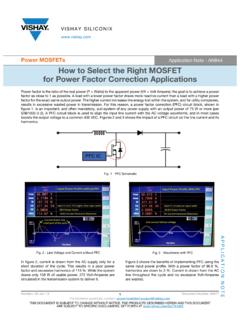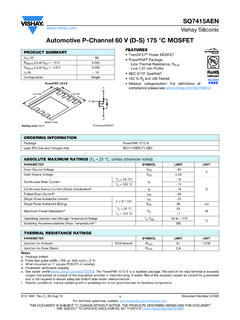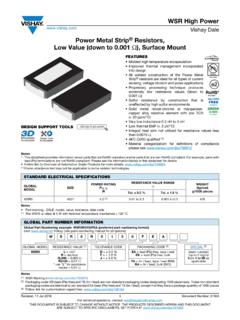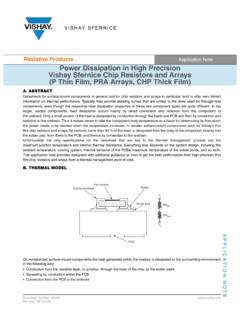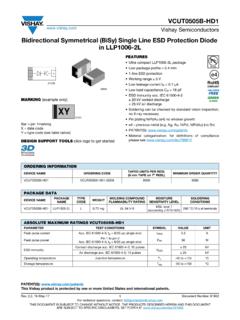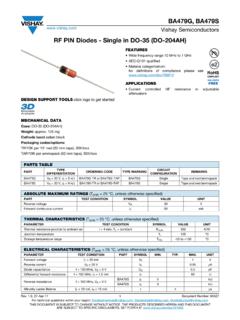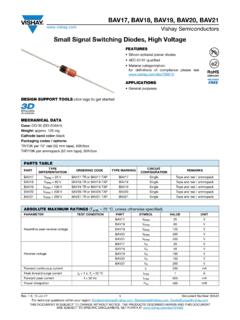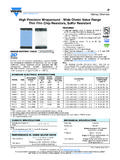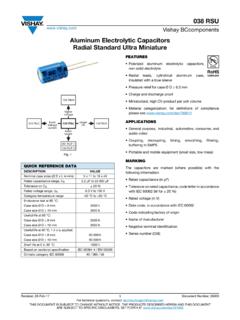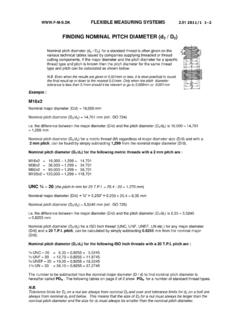Transcription of Hyperfast Rectifier, 30 A FRED Pt - Vishay Intertechnology
1 VS-30 EPH06 PbF, VS-30 EPH06-N3. Vishay Semiconductors Hyperfast rectifier , 30 a fred Pt . Base FEATURES. common Hyperfast recovery time cathode 2 Low forward voltage drop 175 C operating junction temperature Low leakage current Single diode device Designed and qualified according to 1 3. JEDEC -JESD 47 Available TO-247AC modified Cathode Anode Material categorization: . for definitions of compliance please see DESCRIPTION / APPLICATIONS. PRIMARY CHARACTERISTICS. State of the art Hyperfast recovery rectifiers designed with IF(AV) 30 A. optimized performance of forward voltage drop, Hyperfast VR 600 V recovery time and soft recovery.
2 VF at IF V The planar structure and the platinum doped life time trr typ. See Recovery table control guarantee the best overall performance, ruggedness TJ max. 175 C and reliability characteristics.. These devices are intended for use in PFC boost stage in Package TO-247AC modified the AC/DC section of SMPS, inverters or as freewheeling Circuit configuration Single diodes.. Their extremely optimized stored charge and low recovery current minimize the switching losses and reduce over dissipation in the switching element and snubbers. ABSOLUTE MAXIMUM RATINGS. PARAMETER SYMBOL TEST CONDITIONS VALUES UNITS. Peak repetitive reverse voltage VRRM 600 V.
3 Average rectified forward current IF(AV) TC = 116 C 30. A. Non-repetitive peak surge current IFSM TJ = 25 C 300. Operating junction and storage temperatures TJ, TStg -65 to +175 C. ELECTRICAL SPECIFICATIONS (TJ = 25 C unless otherwise specified). PARAMETER SYMBOL TEST CONDITIONS MIN. TYP. MAX. UNITS. Breakdown voltage, VBR, IR = 100 A 600 - - blocking voltage VR. V. IF = 30 A - Forward voltage VF. IF = 30 A, TJ = 150 C - VR = VR rated - 50. Reverse leakage current IR A. TJ = 150 C, VR = VR rated - 60 500. Junction capacitance CT VR = 600 V - 33 - pF. Series inductance LS Measured lead to lead 5 mm from package body - - nH.
4 Revision: 05-Nov-2018 1 Document Number: 94018. For technical questions within your region: THIS DOCUMENT IS SUBJECT TO CHANGE WITHOUT NOTICE. THE PRODUCTS DESCRIBED HEREIN AND THIS DOCUMENT. ARE SUBJECT TO SPECIFIC DISCLAIMERS, SET FORTH AT VS-30 EPH06 PbF, VS-30 EPH06-N3. Vishay Semiconductors DYNAMIC RECOVERY CHARACTERISTICS (TJ = 25 C unless otherwise specified). PARAMETER SYMBOL TEST CONDITIONS MIN. TYP. MAX. UNITS. IF = A, dIF/dt = 50 A/ s, VR = 30 V - 28 35. Reverse recovery time trr TJ = 25 C - 31 - ns TJ = 125 C - 77 - TJ = 25 C IF = 30 A - - Peak recovery current IRRM dIF/dt = 200 A/ s A. TJ = 125 C VR = 200 V - - TJ = 25 C - 65 - Reverse recovery charge Qrr nC.
5 TJ = 125 C - 345 - THERMAL - MECHANICAL SPECIFICATIONS. PARAMETER SYMBOL TEST CONDITIONS MIN. TYP. MAX. UNITS. Maximum junction and storage . TJ, TStg -65 - 175 C. temperature range Thermal resistance, . RthJC - junction to case per leg Thermal resistance, . RthJA Typical socket mount - - 70 C/W. junction to ambient per leg Thermal resistance, Mounting surface, flat, smooth . RthCS - - case to heatsink and greased - - g Weight - - oz. 12 kgf cm Mounting torque - ( ) (10) (lbf in). Marking device Case style TO-247AC modified 30 EPH06. Revision: 05-Nov-2018 2 Document Number: 94018. For technical questions within your region: THIS DOCUMENT IS SUBJECT TO CHANGE WITHOUT NOTICE.
6 THE PRODUCTS DESCRIBED HEREIN AND THIS DOCUMENT. ARE SUBJECT TO SPECIFIC DISCLAIMERS, SET FORTH AT VS-30 EPH06 PbF, VS-30 EPH06-N3. Vishay Semiconductors 1000 1000. 100 TJ = 175 C. IR - Reverse Current ( A). TJ = 150 C. Forward Current (A). IF - Instantaneous 10. 100 TJ = 125 C. 1 TJ = 100 C. TJ = 175 C TJ = 150 C TJ = 25 C. 10 TJ = 25 C. 1 0 1 2 3 0 100 200 300 400 500 600. VF - Forward Voltage Drop (V) VR - Reverse Voltage (V). Fig. 1 - Typical Forward Voltage Drop Characteristics Fig. 2 - Typical Values of Reverse Current vs. Reverse Voltage 1000. CT - Junction Capacitance (pF). 100. TJ = 25 C. 10. 0 100 200 300 400 500 600.
7 VR - Reverse Voltage (V). Fig. 3 - Typical Junction Capacitance vs. Reverse Voltage 1. ZthJC - Thermal Impedance ( C/W). D = PDM. D = D = t1. D = t2. D = Single pulse D = (thermal resistance) Notes: 1. Duty factor D = t1/t2 . 2. Peak TJ = PDM x ZthJC + TC.. 1 10. t1 - Rectangular Pulse Duration (s). Fig. 4 - Maximum Thermal Impedance ZthJC Characteristics Revision: 05-Nov-2018 3 Document Number: 94018. For technical questions within your region: THIS DOCUMENT IS SUBJECT TO CHANGE WITHOUT NOTICE. THE PRODUCTS DESCRIBED HEREIN AND THIS DOCUMENT. ARE SUBJECT TO SPECIFIC DISCLAIMERS, SET FORTH AT VS-30 EPH06 PbF, VS-30 EPH06-N3.
8 Vishay Semiconductors 180 90. Allowable Case Temperature ( C). IF = 30 A. 80 IF = 15 A. 160 70. DC. 60. 140. trr (ns). 50. Square wave (D = ). Rated VR applied 40. 120. 30. 100 20 VR = 200 V. 10 TJ = 125 C. See note (1) TJ = 25 C. 80 0. 0 5 10 15 20 25 30 35 40 45 100 1000. IF(AV) - Average Forward Current (A) dIF/dt (A/ s). Fig. 5 - Maximum Allowable Case Temperature vs. Fig. 7 - Typical Reverse Recovery Time vs. dIF/dt Average Forward Current 90 1200. VR = 200 V. 80 TJ = 125 C. 1000. Average Power Loss (W). TJ = 25 C. 70. RMS limit 60 800. IF = 30 A. Qrr (nC). 50 IF = 15 A. D = 600. 40 D = D = 30 D = 400. 20 D = D = 200.
9 10 DC. 0 0. 0 5 10 15 20 25 30 35 40 45 100 1000. IF(AV) - Average Forward Current (A) dIF/dt (A/ s). Fig. 6 - Forward Power Loss Characteristics Fig. 8 - Typical Stored Charge vs. dIF/dt Note (1). Formula used: TC = TJ - (Pd + PdREV) x RthJC; . Pd = forward power loss = IF(AV) x VFM at (IF(AV)/D) (see fig. 6); . PdREV = inverse power loss = VR1 x IR (1 - D); IR at VR1 = rated VR .. VR = 200 V.. L = 70 H. D. dIF/dt adjust G IRFP250. S. Fig. 9 - Reverse Recovery Parameter Test Circuit Revision: 05-Nov-2018 4 Document Number: 94018. For technical questions within your region: THIS DOCUMENT IS SUBJECT TO CHANGE WITHOUT NOTICE.
10 THE PRODUCTS DESCRIBED HEREIN AND THIS DOCUMENT. ARE SUBJECT TO SPECIFIC DISCLAIMERS, SET FORTH AT VS-30 EPH06 PbF, VS-30 EPH06-N3. Vishay Semiconductors (3). trr IF. ta tb 0. (4). Qrr (2). IRRM IRRM. di(rec)M/dt (5). IRRM. (1) diF/dt (1) diF/dt - rate of change of current (4) Qrr - area under curve defined by trr through zero crossing and IRRM. trr x IRRM. (2) IRRM - peak reverse recovery current Qrr =. 2. (3) trr - reverse recovery time measured (5) di(rec)M/dt - peak rate of change of from zero crossing point of negative current during tb portion of trr going IF to point where a line passing through IRRM and IRRM. extrapolated to zero current.
